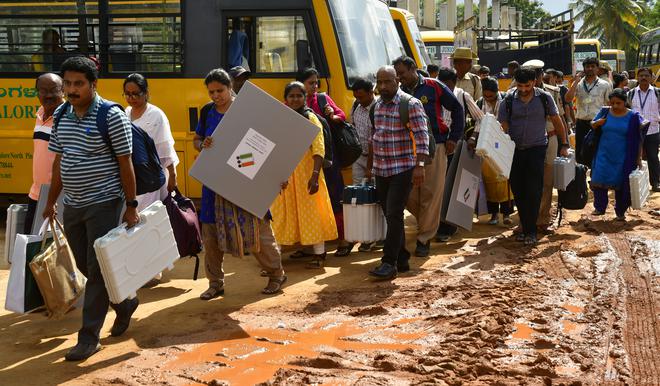
After a fortnight of high-decibel poll campaigns, Karnataka is set to vote on Wednesday to elect a new government. A crucial election for all three key parties, the BJP is fighting to retain power beating anti-incumbency and a history of no ruling party getting re-elected for nearly four decades, while a resurgent Congress has mounted a challenge. Janata Dal (Secular) is fighting to retain its identity in State politics.
Historical trend
Since the Janata Party retained power in 1985 elections, no other government has been able to repeat the feat.
As many as 5.31 crore electors, including 2.64 crore women and 4,927 third genders, will exercise their franchise to elect representatives to the 16 th Legislative Assembly of Karnataka. A total of 2,615 candidates are in the fray across 224 constituencies and the results will be announced on May 13. All the three parties are also besieged by rebels remaining in the fray.
The election outcome in the only BJP-ruled State in the South is also being keenly watched nationally as it is expected to set the tone for the 2024 general elections besides elections to a host of State Assemblies, including Rajasthan, Madhya Pradesh and Telangana.
What parties bank on
The BJP, which seemed to be on the back foot in the run-up to the election with a perceived anti-incumbency, corruption charges, and an “anti-Lingayat” tag after the exit of Lingayat leaders Jagadish Shettar and Laxman Savadi, is hoping to harness the blitzkrieg campaign unleashed by Prime Minister Narendra Modi and Home Minister Amit Shah among the many Central leaders. The saffron party that in 2008 and 2018 came tantalisingly close to securing simple majority, but formed governments through engineered defections (Operation Kamala), is banking on support of communities that will benefit from changes brought to the reservation matrix at the end of its tenure, and the Hindutva plank in Coastal Karnataka.
The Congress with its five “guarantees” and a host of other welfare promises is hoping to make a comeback with Rahul Gandhi and Priyanka Gandhi leading the campaign. It has gone aggressive on “40% commission” corruption charges against the government.
For AICC president Mallikarjun Kharge, the elections will also be crucial as it’s the first big election faced by him after he took over, and Congress performance in his home State could reflect on him. While the Congress is hoping to improve on its performance in Kalyana Karnataka region due to Mr. Kharge’s influence, it is hoping to cash on the Lingayat factor in the Kittur Karnataka and Central Karnataka region.
On the other hand, the regional outfit Janata Dal (Secular), which was the first off the block in poll campaigns, has pitchforked Pancharatna schemes, and former Chief Minister H.D. Kumaraswamy remained their star campaigner, visiting over 110 constituencies while his father and former Prime Minister H.D. Deve Gowda – despite his advanced age and illness - lent support. The party is hoping to repeat its 2018 performance in the Vokkaliga-dominated Old Mysore region.
Campaign styles
The election also marked contrasting campaign styles of BJP and Congress. Mr. Modi pitched his “double engine sarkar” for development, mainly focusing on the Central schemes and attacking Congress and JD (S) but rarely speaking on the ruling BJP in the State. His connect with the people came through well-attended roadshows, especially the 36-km roadshow in Bengaluru. In contrast, Mr. Gandhi spoke extensively on the party’s poll promises, price rise, local issues, candidates and more often was seen mingling with the commoner besides his rallies and roadshows that too attracted people.
Even as the campaigns gathered pace, they also became vitriolic, diverting the attention from the people’s issue. If the “Vishasarpa” remark of Mr. Kharge in the initial stage was used by the BJP to divert the campaign focus, the Congress’s manifesto’s mention of on Bajrang Dal brought life back to Hindutva campaign of the BJP during the last phase of electioneering. Mr. Modi chanted “Bajrang Bali Ki Jai” in almost every campaign after that.
Complaints to EC
Election Commission of India also came under sharp criticism by the Congress, which after being issued notice over an advertisement, accused it of providing unequal playing field to the opposition, ignoring complaints of violation of model code of conduct by BJP leaders, including Mr. Modi and Mr. Shah. EC subsequently also issued a notice to the BJP on its advertisement as well.







